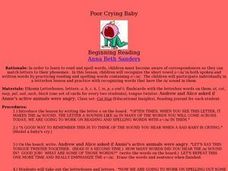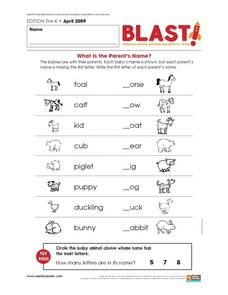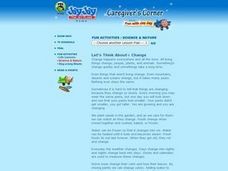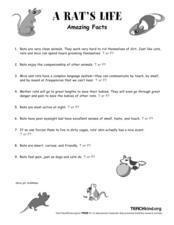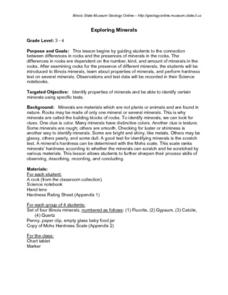K12 Reader
Adapting to Survive
Life science and language arts come together in a passage about animal adaptation. After kids learn about how organisms adapt to conditions in their environments, they complete five reading comprehension questions based on context clues...
United K12
Jan Brett Author Study
Expose young children to the wonderful works of author and illustrator Jan Brett using a few of her stories such as Armadillo Rodeo, The Mitten, or Daisy Comes Home through a unit study.
Curated OER
Baby Animals
In this baby animals worksheet, students will color and cut out six adult animal cards and six baby animal. Then students will match the adult to the correct baby animal.
Curated OER
Animal Idioms
In this grammar worksheet, students read the 10 sentences with idioms and select the correct meaning of the idiom. This is an interactive, multiple choice worksheet.
Curated OER
Horseshoe Crab Fun
Marine biology masters will meet the horseshoe crab and red knot shore birds that feast upon the crab eggs. Begin with a discussion and then have learners write postcards from each animal detailing their migration trips. A few math...
Curated OER
Poor Crying Baby
Students examine the letter 'a'. Through instruction and modeling and a variety of practice activities, they explore the sound the letter makes and how the letter is written. They recite tongue twisters and read stories and pick out...
Curated OER
The Crying Baby says Waa! Waa!
Students practice identifying and writing the letter "a." They say a tongue twister and identify the words with short letter "a" sounds. They then listen to the teacher read "A Cat Nap" and identify the words that have the "a" sound. ...
Curated OER
The Name Game
Students identify animals and their babies. In this animal name lesson, students come up with other animals whose babies have the same name. Students use the names of animals and their babies to write poems.
Curated OER
Bringing Up Birdy
Learners explore biology by creating diagrams of animal life cycles. In this baby bird lesson, students view video clips of birds being born from incubation to flying on their own. Learners utilize the Internet to research birds and...
Curated OER
What is the Parent's Name?
In this early childhood word recognition worksheet, learners read the 8 baby animal's names and fill in the blanks of the matching adult animal's names with the correct letter.
Curated OER
Adding More Details To Sentences
In this writing worksheet, 3rd graders rewrite 4 sentences adding more details to each. They enhance sentences about a field trip, animals, baby animal, and a picnic in the park.
Curated OER
Humans Leave Bob Bat Homeless!
For this science worksheet, students read an "interview" with a bat who has been displaced from his home in the rainforest. Using a word bank, students fill in 20 missing words from the script. Students then answer 10 questions about...
Curated OER
Fleece, Feathers, and Fur
Students improve vocabulary and explore predicting and categorizing after reading the book, Is Your Mama a Llama?
Curated OER
My Family and Me: Our Similarities and Differences
Students are introduced to basic genetic information to discover how they acquired the traits they have. Individually, they develop a family tree and identify the similarities and differences between two poeple. In groups, they examine...
Curated OER
Baby Animals
In this literacy worksheet, learners match the baby and adult animals. They use the cutouts to play a matching game and they be colored also.
Curated OER
AAAAAAAAAAA! Stop Crying!
Students practice recognizing the phoneme /a/ in spoken words. They interact with the book, "A Cat's Nap," and a poster with Abby and Allen on it that are asking animals for apples, and cards with words on them like at, mad, went, bag,...
Curated OER
A World of Feathered Friends
learners will learn to
respect the nature around them. This respect is vital because ignorance of surrounding
nature can lead to carelessness when curiosity goes awry. A perfect example of this
wayward curiosity took place at our school...
Curated OER
Let's Think About... Change
Students observe various examples of "change." They mix paint to cereate new colors, eat bread and then toasted bread, and match baby pictures with pictures of how the same people look in the present. Finally, they watch a bouquet of...
Curated OER
Animal Identification and Matching
In this animal identification and matching worksheet, students name the 8 animals pictured, then match the animal with its baby by cutting and pasting or drawing lines.
Curated OER
What am I?
In this animal related worksheet, young scholars read and analyze each clue card to figure out what animal is being described and check their answers against the answer key.
Curated OER
A Rat's Life
Here is a two-page worksheet on rats and mice. Learners answer nine true/false questions about rats and mice, then compose answers to seven short-answer questions about these two rodents. Finally, they must compose a fictional story...
Curated OER
Exploring Minerals
I love this geology lesson plan. Third and fourth graders look at the connections, and the differences, between rocks and minerals. Learners are charged with identifying specific rocks and minerals, learning how to properly use...
K5 Learning
Sharks
"Dun dun... dun dun." A shark! After second graders read a four-paragraph passage about sharks, they respond to four reading comprehension questions that use the text as a basis for the answers.
K12 Reader
Find the Main Idea: The Meerkat
After examining a short article about African meerkats, readers identify the main idea and supporting ideas in the paragraph.







